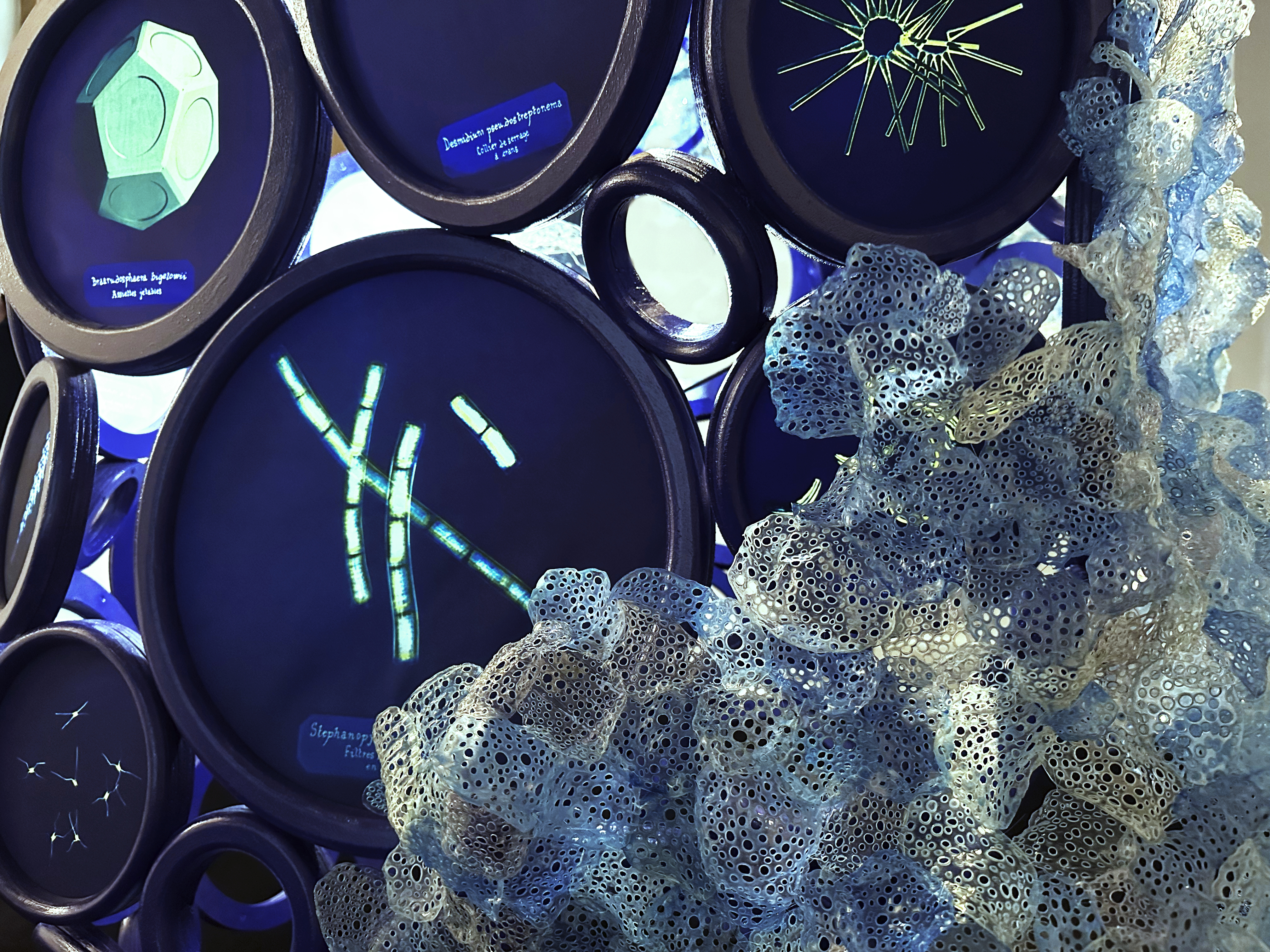P·O·E·M
(
Particules de polyéthylène modèles pour l’étude des micro/nano- plastiques dans les océans)2023
The P·O·E·M installation was designed for the Photoclimat 2023 biennial. This photographic sculpture, based on the series "Les Particules" , came about following a conversation with Ika Paul-Pont, a researcher in Marine Ecotoxicology at LEMAR, who specialises in the effects of micro- and nano-plastics on coastal ecosystems.
backlit photos on cotton fabric, wood structure and plastic wave made of more than 200 plastic bottles thanks to the help of Cèdre Recyclons solidaire.
team /
Head Carpenter : Luca Venegas
Head Seamstress : Johanna Batardy
Assistant : Natacha Scandella & Vincent Ineichen

preparatory sketch
As a victim of our frugalism and the illusory recyclability of plastics, we dump eight million tonnes of them into the ocean every year. At this lightning pace, and without any real action on our part, the amount of plastic in the ocean is set to triple by 2050. According to the UN, the sea would then be home to more plastic waste than fish. Only 1% of the ocean's plastic waste is on the surface, while 99% is not found because it has sunk to the bottom, washed up on the coast or, above all, disintegrated. Plastics break down into smaller and smaller particles, forming microplastics smaller than five millimetres, which make up the bulk of plastic pollution in the ocean.
Some of these particles are assimilated by phytoplankton, unicellular organisms otherwise known as cyanobacteria and micro-algae. Representing less than 1% of the Earth's photosynthetic mass, these tiny aquatic plants are responsible for 30% / 40% of carbon dioxide absorption and more than 50% of oxygen production, a phenomenal and chilling figure given their vulnerability to micro-plastics. Once inside the bodies of these planktonic species, micro-plastics reflect the sun's rays and prevent photosynthesis, reducing production by up to 45%. In addition, the permeability of phytoplankton to microplastics represents a direct health hazard for humans and animals. It is one of the major routes of contamination through trophic transfer between the various links in the food chain. Because of their very small size, these particles slip through the net and unfortunately cannot be recovered.
This research into plastic pollution and its impact on micro-organisms began on board the scientific schooner Tara and has continued with a conversation with Ika Paul-Pont, a researcher in Marine Ecotoxicology at LEMAR, who specialises in the effects of micro- and nano-plastics on coastal ecosystems.
Throughout our conversation, I discovered that microplastics, which travel over a very long time scale, are carried by currents. Species, bacteria and pathologies settle on them, crossing gigantic swathes of ocean to end up on the other side of the planet, partly threatening the native species of the areas in which they end up. As a conductive material, plastic allows certain (cyano)bacteria and toxic algae to develop, but above all it is responsible for the transfer of data and genes between viruses and species.
The installation, which takes the form of a molecule and the DNA helix, evokes the idea that with plastic and chemical pollution, humans are changing the very essence of the ocean. The helix made from recycled plastic fragments is already showing some missing parts, those commonly known as "mermaids' tears". Taking on an organic appearance, this wave already shows a transformation of nature. In a gesture of repair, the plastic fragments are sewn together, inviting us to rethink our relationship with living things and the impact of human actions.
Some of these particles are assimilated by phytoplankton, unicellular organisms otherwise known as cyanobacteria and micro-algae. Representing less than 1% of the Earth's photosynthetic mass, these tiny aquatic plants are responsible for 30% / 40% of carbon dioxide absorption and more than 50% of oxygen production, a phenomenal and chilling figure given their vulnerability to micro-plastics. Once inside the bodies of these planktonic species, micro-plastics reflect the sun's rays and prevent photosynthesis, reducing production by up to 45%. In addition, the permeability of phytoplankton to microplastics represents a direct health hazard for humans and animals. It is one of the major routes of contamination through trophic transfer between the various links in the food chain. Because of their very small size, these particles slip through the net and unfortunately cannot be recovered.
This research into plastic pollution and its impact on micro-organisms began on board the scientific schooner Tara and has continued with a conversation with Ika Paul-Pont, a researcher in Marine Ecotoxicology at LEMAR, who specialises in the effects of micro- and nano-plastics on coastal ecosystems.
Throughout our conversation, I discovered that microplastics, which travel over a very long time scale, are carried by currents. Species, bacteria and pathologies settle on them, crossing gigantic swathes of ocean to end up on the other side of the planet, partly threatening the native species of the areas in which they end up. As a conductive material, plastic allows certain (cyano)bacteria and toxic algae to develop, but above all it is responsible for the transfer of data and genes between viruses and species.
The installation, which takes the form of a molecule and the DNA helix, evokes the idea that with plastic and chemical pollution, humans are changing the very essence of the ocean. The helix made from recycled plastic fragments is already showing some missing parts, those commonly known as "mermaids' tears". Taking on an organic appearance, this wave already shows a transformation of nature. In a gesture of repair, the plastic fragments are sewn together, inviting us to rethink our relationship with living things and the impact of human actions.




detail of the installation for the biennial Photoclimat, in Académie du Climat in Paris